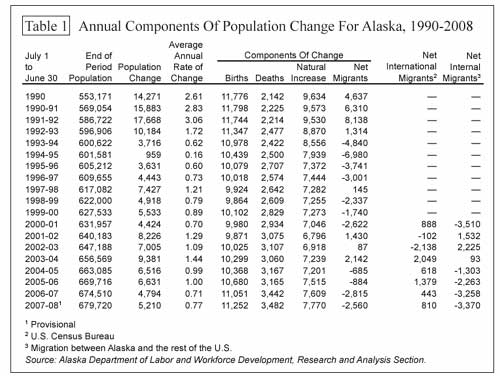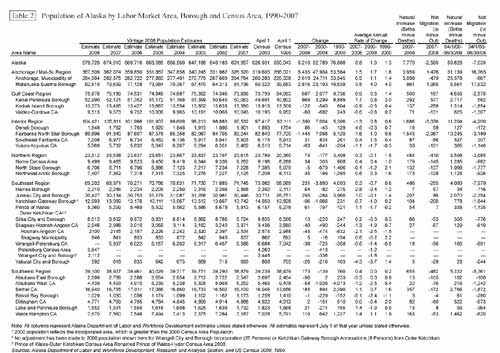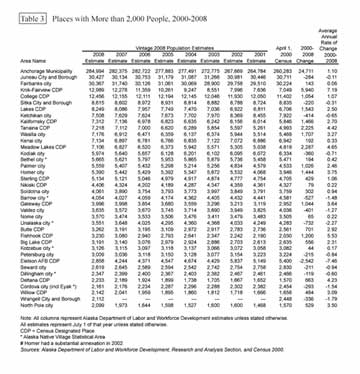 March 17, 2009
Alaska's growth was almost the same as the 8 percent increase for the United States as a whole during the eight year period. The 2008 estimates are provisional. The number of people living in Alaska climbed from 627,533 in 2000 to 679,720 in 2008 (See Table 1). Alaska's average annual rate of population change was 1.1 percent during the 2000-2008 period and 0.8 percent for the 2007-2008 period. Alaska remains the 47th most populous state, and is larger than North Dakota, Vermont, the District of Columbia and Wyoming.  Table 1 Population Change for Alaska, 1990-2008 Click on the image to view a larger image.
When international and domestic migration are considered separately, the loss of 2,560 migrants between 2007 and 2008 breaks down to a gain of 810 international migrants and a loss of 3,370 domestic migrants. Thus, international migration is currently compensating for some of the outward domestic migration. About 92,500 people now migrate to and from Alaska each year. In- and out-migration are nearly equal at about 45,000 in and 47,500 out. "It is important to note that, because our estimates are for resident population, any troops deployed overseas are counted as being in Alaska in our estimates," said Greg Williams, state demographer. "This means that the populations for the Fairbanks North Star Borough and the Municipality of Anchorage, where the main Alaska military bases are located, as well as other communities with a substantial National Guard presence, may be somewhat lower than these estimates indicate, depending on the current deployment of military and National Guard personnel." Boroughs and Census Areas Alaska Department of Labor population estimates have also been released for Alaska's 29 boroughs and census areas (see Table 2), as well as for 349 places located throughout the state. Unlike Table 1, which considers population change from the average annual population in 2000, Table 2 and the remainder of this press release consider population change from the April 1, 2000 U.S. Census.  Population of Alaska by Borough Click on the image to view a larger image
The largest population increases occurred in the Municipality of Anchorage (+24,711), Matanuska-Susitna Borough (+23,193), Fairbanks North Star Borough (+7,056), Kenai Peninsula Borough (+3,299), Bethel Census Area (+894), Southeast Fairbanks Census Area (+834) and Wade Hampton Census Area (+642). Population growth in the Municipality of Anchorage and the Mat-Su Borough accounted for roughly 78.4 percent of the growth in those 10 boroughs and census areas. The Municipality of Anchorage made up 40.4 percent of the growth, with population gains in the Mat-Su Borough making up 37.9 percent. The Mat-Su Borough continued in 2008 to be the fastest-growing area in the state, as it has been since 1990. Between 2000 and 2008, it grew at an average annual rate of 4.0 percent, the same annual growth rate during the 1990s. However, its growth slowed to 3.5 percent between 2007 and 2008. The increases in both the Municipality of Anchorage and the Mat-Su Borough between 2000 and 2008 were due to a mix of natural increase and net-migration. About a quarter of the in and out migration to Anchorage in 2007- 2008 came from other parts of Alaska, the remainder came from out of state. Of the in-state migration to and from Anchorage, 28 percent came into Anchorage from Mat-Su, while 47 percent of the in-state migration from Anchorage went out to the Mat-Su Borough. The Mat-Su Borough was the only area of the state where growth came primarily from net in-migration. Since the 2000 Census, net in-migration accounted for 17,632 or 76 percent of the Mat-Su Borough's population increase of 23,193. The Mat-Su Borough, Kenai Peninsula Borough (+582), and Southeast Fairbanks Census Area (+307) were the only areas where in-migration noticeably exceeded out-migration during the 2000-2008 period. In the more recent 2007-2008 period, Anchorage gained a total of 2,619 people, while the Mat-Su Borough gained 2,816 people. And while Anchorage had a current natural increase of 3,098 compared to the Mat-Su Borough's 861, Mat-Su gained 1,955 migrants and Anchorage lost 479. Nineteen boroughs and census areas lost population between 2000 and 2008. The Southeast region continued to have the largest overall decline, losing 5.6 percent of its population since 2000, with a natural increase of 4,099 people and a net out-migration of 7,979 people. No Southeast area had long-term growth between 2000 and 2008. In the 2007-2008 period, only Juneau (+86), Haines Borough (+57) and Prince of Wales-Outer Ketchikan (+7) had any population gain. In all the rest of the Southeast area, out-migration was greater than natural increase due to net migration. In part, that was due to population aging in the region. Between 2000 and 2008, net out-migration from Southwest Alaska (-5,361) was greater than the natural increase in the region (+5,222). The Southwest areas that increased were the Bethel Census Area, and Wade Hampton Census Area. In every other area of Southwest, net out-migration exceeded natural increase or broke even. In the Northern region, natural increase (+3,508) failed to keep up with out-migration (-3,685). The greatest loss was in North Slope Borough where outmigration (1,777) substantially exceeded natural increase (1,098). Nome and Northwest Arctic Borough had a natural increase that was slightly higher than out-migration. In the Gulf Coast region, natural increase (+4,656) kept ahead of out-migration (-2,549) between 2000 and 2008. The Kodiak Island Borough had more net out-migration (-1,854) than natural increase (+1,314) and the Valdez- Cordova Census Area declined as natural increase (+625) failed to match net out-migration (-1,307). The Kenai Peninsula Borough grew mainly through natural increase (+2,717) as opposed to net-migration (+582). During the 2007-2008 period, the Valdez-Cordova Census Area declined as net out-migration (-131) exceeded natural increase (+71). In the Kenai Peninsula Borough, however, both natural increase (+292) and net-migration (+577) were positive. The Kodiak Island Borough lost because natural increase (+137) was less than out-migration (-259). In the Interior, the Fairbanks North Star Borough (+7,056) and Southeast Fairbanks Census Area (+834) grew in the 2000-2008 period, largely due to natural increase. The Yukon-Koyukuk Census Area (-841) and Denali Borough (-45) shrank as out-migration exceeded natural increase. During the 2007-2008 period, Fairbanks North Star Borough (-1,444) and Yukon-Koyukuk Census Area (-63) had population losses. Denali Borough (+86) and Southeast Fairbanks Census Area (+31) had slight gains. In Fairbanks North Star Borough, natural increase (+1,543) was exceeded by net out-migration (-2,987). The net out-migration was mostly military and dependents associated with the loss of a Fighter Wing at Eielson AFB. Places Alaska had 36 places with populations of more than 2,000 in the year 2008 (see Table 3); 23 of them were incorporated cities or city-boroughs in 2008. Thirty-eight places in Alaska had populations of more than 2,000 in 2008.
The Municipality of Anchorage continued to dominate the state. Its population of 284,994 in 2008 accounted for 41.9 percent of the state's population, up slightly from 41.5 percent in 2000. The Anchorage/Mat-Su region (367,509) accounted for 54.1 percent of Alaska's population in 2008, up from 51.0 percent in 2000. The 15 places with populations greater than 2,000 that have had average annual growth rates above 2.0 percent since the 2000 Census include the Knik-Fairview Census Designated Place, or CDP, (+7.2 percent), Fishhook CDP (+5.5 percent), Meadow Lakes CDP (+4.7 percent), Tanaina CDP (+4.4 percent), Deltana CDP (+4.2 percent), Homer city (+3.8 percent), Gateway CDP (+3.6 percent), North Pole city (+3.5 percent), Wasilla city (+3.3 percent), Willow CDP (+3.1 percent), Butte CDP (+2.9 percent), Kalifornsky CDP (+2.7 percent), Lakes CDP (+2.5 percent), Palmer city (+2.5 percent), Big Lake CDP (+2.3 percent). Eleven of the top 15 places that experienced the most rapid growth between 2000 and 2008 are in the Mat-Su Borough. Indeed, if they were to incorporate, three places in the Mat-Su Borough would be larger than Wasilla city. Knik-Fairview would become the fourth-largest city in the state. Of the remaining four rapidly growing places, the Kalifornsky CDP and Homer city are in the Kenai Peninsula Borough, Deltana CDP is in the Southeast Fairbanks Census Area and North Pole city is in Fairbanks North Star Borough. Homer's growth is largely due to its annexation of a substantial part of Diamond Ridge CDP and Miller Landing CDP in 2002. "Outside the Anchorage/Mat-Su region, a majority of communities have flat or declining populations," Williams said. "Thirteen of the places that had more than 2,000 people in 2000 have since declined. In fact, 198 (56 percent) of the 349 places in Alaska have had either zero gains or population losses since the 2000 Census. That includes fi ve of the largest communities: the Juneau city and borough, Sitka city and borough, Ketchikan city, Kodiak city and Barrow city." The larger places that declined
an average by more than 1.0 percent each year during the 2000-2008
period were Eielson Air Force Base CDP (-7.5 percent), Unalaska
city (-2.3 percent), Wrangell City and Borough (-1.8 percent),
Cordova city (-1.5 percent), Barrow city (-1.5 percent), and
Valdez city (-1.3 percent).
Source of News:
Publish A Letter in SitNews Read Letters/Opinions
|
||
